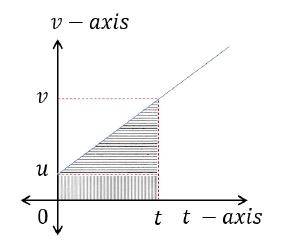Third Equation of Motion
Description:
The Concept
Equations of Motion are designed to analyze motions with constant acceleration.
They relate kinematic variables velocity, displacement, acceleration and time in different ways.
In daily life, there are many instances of the motion with constant acceleration:
Freely falling objects
Objects slipping down the incline plane
Car starting from rest, etc.
Third Equation
v2 = u2 + 2aS
where,
v = final velocity,
S = displacement,
u = initial velocity,
a = acceleration (must be constant),
This equation DOES NOT relate to final velocity.
Analytical Proof
We know that,
a = dvdt
v = dSdt
Taking their ratio, we get,
av = dvdS
Hence,
a = vdvdS
Cross multiplying ‘dS’ and integrating both sides,
S∫0 a . dS = v∫u v . dv ⇒ aS = v2 - u22
v2 = u2 + 2aS
Graphical Proof
Following is a v − t graph displaying constant acceleration. (Slope of the curve is constant)

At t = 0 seconds, the particle’s velocity is u m/s.
At t = t seconds, the particle’s velocity is v m/s.
Area under the curve of v − t graph gives displacement.
Now,
S = Area of Rectangle + Area of Triangle
S = ut + 12(v - u)(t)
(Substituting t = (v - u)a, from first equation of motion)
S = u(v - ua) + 12(v - u)(v - ua)
Rearranging the terms,
v2 = u2 + 2aS

